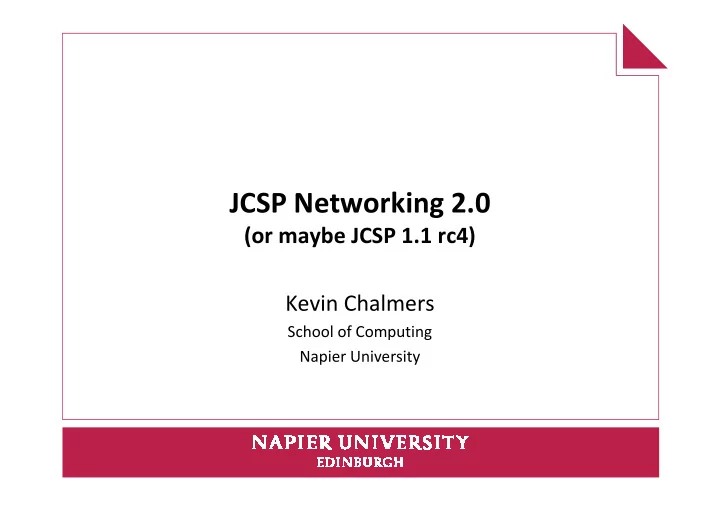

JCSP Networking 2.0 (or maybe JCSP 1.1 rc4) Kevin Chalmers School of Computing Napier University
Aims • Update to JCSP 1.1 – Poisonable network channels – Remove pesky rejectable channels – Extended rendezvous – No networked AltingBarrier (yet!) • Reduce overheads – No process per channel – No LoopbackLink – LinkManager now a passive data object – Smaller message size
Aims • Extensibility, configurability and error handling – Layered model – easier to add extensions – NetworkBarrier! – Better NetworkConnection (soon) – All networked channels mobile (maybe) – Priority of communication layer – Buffer size – Quick creation of channels (no Channel Name Server required) – JCSPNetworkException • Interaction – Towards a universal protocol
Towards a Universal Protocol • Messages are no longer objects – SEND | Destination | Source | < data > – <1, 0, 0, 0, 54, 0, 0, 0, 49, <data>> • Data encoding and decoding handled at channel level – User defined methods possible – Object serialization default, raw data and class loading provided
Layered Model
Layered Model
Creating an Application • Old way • Use Channel Name Server – Can use names – implies lookup on receiving Node Node. getInstance ().init( new TCPIPNodeFactory("CNS_IP")); NetChannelInput in = CNS. createNet2One ("channel_In"); NetChannelOutput out = CNS. createOne2Net ("channel_Out");
Creating an Application • New way Node. getInstance ().init( new TCPIPNodeAddress(5000)); // Create Link to remote Node TCPIPNodeAddress remoteAddr = new TCPIPNodeAddress("192.168.1.100", 4000); // Get NodeID NodeID remoteNode = LinkFactory. getLink (remoteAddr).getRemoteNodeID(); // Create channels NetChannelInput in = NetChannel. numberedNet2One (55); NetChannelOutput out = NetChannel. one2net (remoteNode, 49); • Other methods possible – Original method – From NodeAddress and VCN – From NetChannelLocation
Other Channel Options • Poison NetChannelInput in = NetChannel. net2one (10); NetChannelOutput out = NetChannel. one2net (location, 10); • Specified encoder / decoder NetChannelInput in = NetChannel. net2one( new RawNetworkMessageFilter.FilterRX()); NetChannelOutput out = NetChannel. one2net (location, new RawNetworkMessageFilter.FilterTX()); NetChannelInput in = NetChannel. net2one( new CodeLoadingChannelFilter.FilterRX()); NetChannelOutput out = NetChannel. one2net (location, new CodeLoadingChannelFilter.FilterTX());
NetworkBarrier • Two tier approach – Declaring (server) end – Multiple connecting (client) ends – Each end has n enrolled processes – Server end MUST have one enrolled process
NetworkBarrier • Creation methods – as channels – Barrier Name Server (BNS) NetBarrier servBar = BNS. netBarrier("barrier", 10, 10); NetBarrier clientBar = BNS. netBarrier("barrier", 10); – Numbered barrier ends NetBarrier servBar = NetBarrierEnd. numberedNetBarrier(55, 10, 10); NetBarrier clientBar = NetBarrierEnd. netBarrier(nodeID, 55, 10); • Server end declares both locally enrolled and expected remote client ends.
Error Handling • Channels can throw JCSPNetworkException or NetworkPoisonException – Unchecked exceptions – no need to explicitly catch – If connection to input end fails, the output end will throw a JCSPNetworkException – If there is a problem during I/O (including encoding / decoding) a channel will throw a JCSPNetworkException – If the input end is destroyed, the output end will throw a JCSPNetworkException during next write operation – If a message is sent to an input channel that does not exist, a JCSPNetworkException will be thrown – If a channel end is poisoned with sufficient strength, every complement end will throw a NetworkPoisonException
Error Handling • Barriers can only throw JCSPNetworkException – If the connection to the server NetBarrier fails, a client NetBarrier will throw a JCSPNetworkException and fail. – If the connection to a client NetBarrier fails, a server end will throw a JCSPNetworkException, decrement the enrolled network process count, and allow reuse if required. – If a client end tries to enrol on a non-existent server end, a JCSPNetworkException will be thrown. – If the locally enrolled count on the server end reaches zero, a JCSPNetworkException will be thrown.
Mobility • Non-running process mobility via code mobility – Code loading channel filter – Reduced model from last years paper • Running processes still require termination – Poison – Migration event • Channel mobility via message boxes – Updated model soon.... – Built into protocol?
Wrapping up • New JCSP networking available on the JCSP repository (under the Networking-2 branch) • More information and examples given in handouts – Set up – Channel creation, operations and error handling – Custom encoders and decoders – Network barriers – Mobility – Custom Link protocol creation
Wrapping up • Hopefully everyone’s existing programs will still work – Same interfaces – Some packages not replicated (dynamic, remote, security, settings) • More updates soon, once I’m finished writing up – NetConnections – Better channel mobility – AltingBarrier? • Any requests for functionality / information let me know, and I’ll try and help as much as I can.
Questions?
Recommend
More recommend